The Personal Health Inventory (PHI) is more commonly used, but the longer PHI Booklet can provide additional useful information. Use it if the following are true:
- You have enough time go into more detail during a Whole Health visit.
- Your patient is willing to take the extra time (15-20 minutes, possibly more) to complete it.
- It would be helpful for a patient to take more time to reflect on answers to the questions about Where You Are and Where You Want to Be. In the PHI Booklet, unlike the PHI, there is space to write about the reasons you chose your answers to the questions in this section.
- Your patient has a sufficient literacy level to complete the form. This not only includes reading skills, but also health literacy.
- You want the patient to have more opportunity to read up on Whole Health (a good portion of the PHI Booklet focuses on defining Whole Health and describing the parts of the Circle of Health).
For more information, refer to Bob’s Personal Health Inventory Booklet.
Reviewing Bob's Answers
PHI Booklet Section One: Three Important Questions
- Question #1 cuts right to the chase. It helps the clinician gain a sense of what Bobs mission might be. Remember that defining the mission and focusing the care plan on completing the mission are essential elements of patient-driven care.Bobs missionto participate in his granddaughters weddingstands out immediately. Discussions related to independence, being useful, and his faith could also prove fruitful in guiding the creation of Bobs Personal Health Plan (PHP).

- Question #2 focuses on the positives, which sets a tone of appreciative inquiry that carries through much of the form. The focus becomes what one aspires to, rather than what is wrong.A gratifying part of reviewing PHIs is learning about peoples talents and hobbies. Some practitioners make it a point to learn something from every patient they see. One might ask Bob about the best times of day to do nature photography or what kind of boat he has and whyanything of that nature. We all love to discuss our passions, and taking the conversation somewhere familiar might help Bob relax and open up.

- Question #3 is then built around 3 rating scales that capture Bobs current state of well-being and function. The answers to these questions are called, The Vitality Signs and can give an indication about how a person is doing in general. If someone is suicidal, these questions may be an important indicator of that fact.
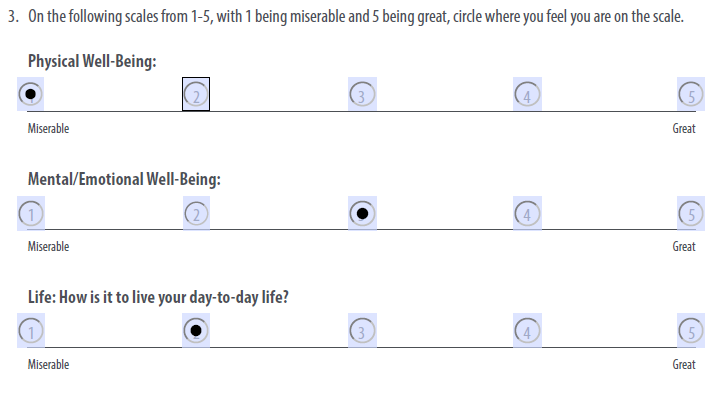
For Bob, there is some definite room for improvement on all 3, but the difference between the physical and mental/emotional well-being numbers might lead the clinician to focus on the physical side first. Asking about the reasons for circling 2 for the last question on living Bobs day-to-day life might also be revealing.
PHI Booklet Section Two: Where you are and Where you would like to be
This section focuses on the eight components of self-care, key aspects of our health that are influenced by both our circumstances and the choices we make in everyday life. A unique aspect of the PHI is that it not only asks patients where they are with each component, but also where they want to be. As with the questions in the first section, this line of questioning gets them thinking about their goals.
If time is limited, this section allows the clinician to make a quick sweep through the circled numbers to assess the following: 1) which areas the person feels are the most problematic, and 2) which areas the person most wants to change. While the numbers are of secondary importance relative to the subjective data the patient provides, they can nonetheless guide the conversation.
The instructions to this section read as follows:
WHERE YOU ARE AND WHERE YOUD LIKE TO BE
For each of the following areas, consider where you are now and where you would like to be. All the areas are important. In the Where you are box, briefly write the reasons you chose your number. In the Where you want to be box, write down some changes that might make this area better for you. Some areas are strongly connected to other areas, so you may notice some of your answers seem the same. Try to fill out as many areas as you can. You do not have to write in every area or in all the areas at one time. You might want to start with the easier ones and come back to the harder ones. It is OK just to circle the numbers.
The form conveys a strong sense of where Bob feels he currently is in each area, as well as his priorities. Presumably, the areas where we see the biggest jump in numbers from Where you are to Where would you like to be would be important areas to discuss with him. Note, however, that this process is not all about the numbers; the numbers can serve as a way in to a conversation. Clinicians working with the Whole Health approach note that some people do not choose to work on the area where they gave themselves the lowest score, or where there was the biggest gap between where they are and where they want to be.
For Bob, the differences in numbers for Moving Your Body and Food and Drink are most striking.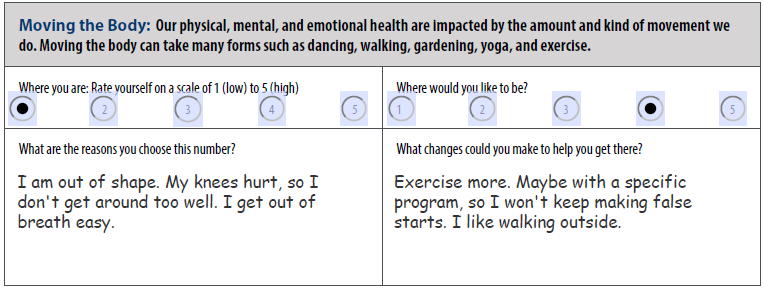
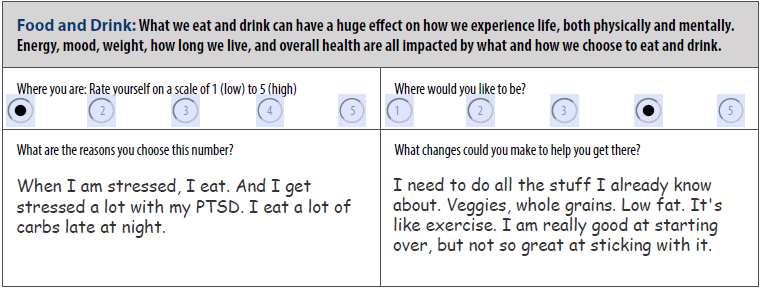
Knowing Bobs health history, you might feel relieved to see that Bob realizes that diet and exercise are of vital importance.
In contrast, some areas might be considered second tier based on the numbers. For instance, look at Bobs responses to Recharge and Family, Friends, and Co-Workers.
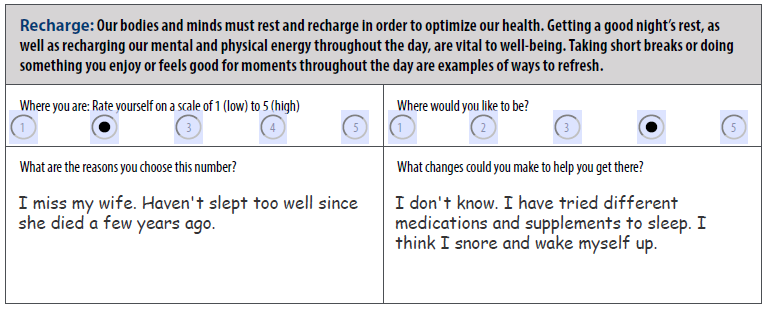
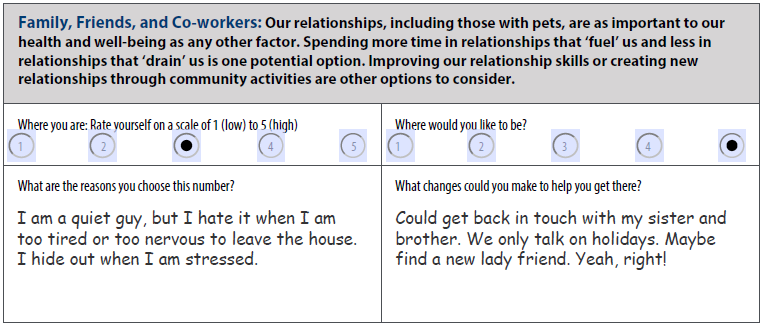
Bobs commentary in the Recharge section suggests that it would be useful to talk to Bob about sleep at some point. If sleep apnea turns out to be an issue, it should, of course, be given high priority.Bob mentions wanting to have a romantic partner a few times in the form.That also may be worth exploring as time allows in this or a future visit.
Finally, there are four areas where Bob has few concerns or is doing relatively well. To start your discussion of self-care with Bob, it may be worth highlighting some of these strengths before you begin discussing where he wants to improve. How will these areas help him to reach his goals in the areas where he gave himself lower ratings?
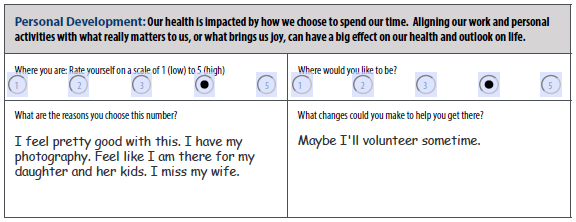
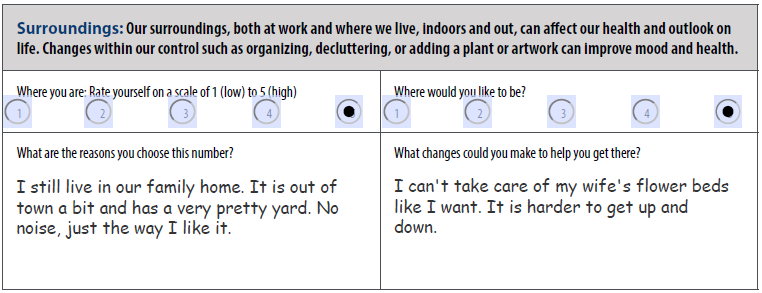
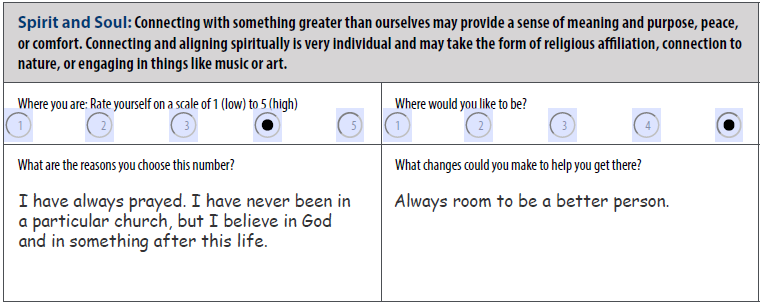
PHI Booklet Section Three: Professional Care
The PHI is designed to ensure that routine preventive care and clinical care have been accessible and of full potential benefit to the patient. The clinical care question, in asking about Bobs understanding of his health problems and his role in addressing them, can help the clinician get a sense of his health literacy.
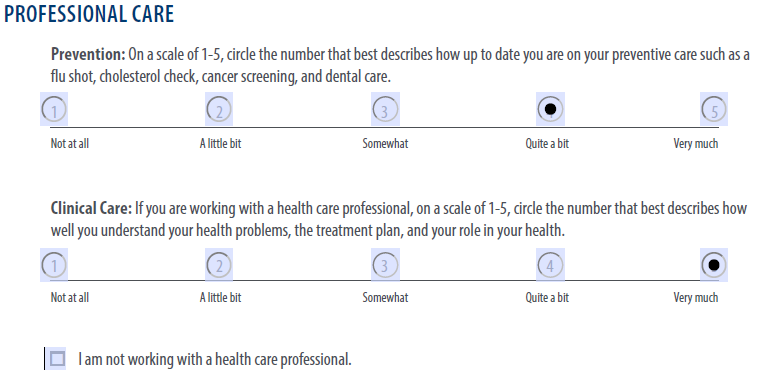
Bob is doing pretty well in this arena. It may be worth it to ask him what aspects of preventive care he feels he is missing.Motivational Interviewing, which many VA personnel have learned, can be useful throughout the conversation, and it is particularly helpful here.[1]
The clinical care question serves as a good reminder to check in with every person about the care they receive outside the clinic as well, from complementary medicine providers, for example. As will be noted in the Implementing Whole Health in Your Practice, Part III: Complementary and Integrative Health for Veterans overview and related Whole Health tools, patients will not always disclose their use of complementary approaches unless specifically asked.
PHI Booklet Section Four: Reflections
In this section, we return to Bobs aspirations. For what reasons does Bob want his health? The first question in this section again encourages people to think in terms of wellness rather than illness. The second question provides additional direction for next steps.
Since patient-driven care involves patients as the leaders of their own care teams, it makes sense that the people, like Bob, be encouraged to offer their own initial thoughts regarding what should be given priority in their PHPs. By teasing out his thoughts, the PHI encourages Bob to make a great start on creating his PHP.
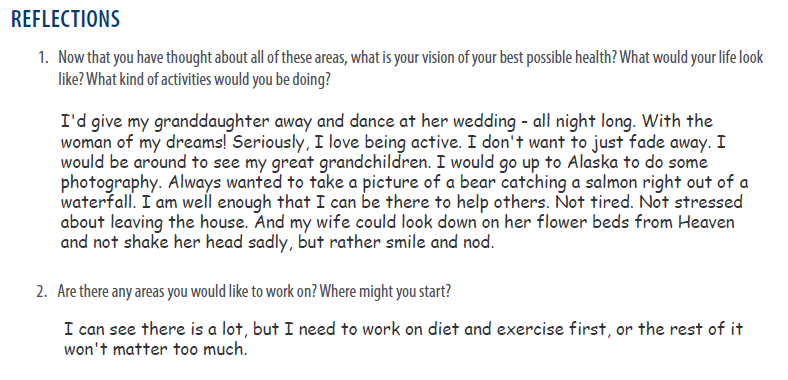
By answering these questions on the PHI, Bob helps to set the priorities for his care before he even starts speaking to you. And you have the pleasure of learning some things about Bob you might not have picked up previously.
With a little practice, a clinician can acquire a lot of valuable information after just a few minutes of having looked over the PHI. Because the form can be filled out and reviewed in advance of the visit, using it can potentially save the clinician time. Additionally, given that you can use the same PHI to guide multiple visits in the future, there is the potential for even greater time savings in the long run.
Conclusion
When appropriate, the PHI Booklet can be a nice addition to your Whole Health practice. Remember, in a Whole Health System, every member of the team will be doing their part with reviewing a Veterans PHP and supporting the Veteran with next steps. The PHI Booklet, as we have seen here in Bobs case, can be one of many powerful tools you can use to move the planning process forward.
Author(s)
Reviewing Bobs Personal Health Inventory Booklet was written by J. Adam Rindfleisch, MPhil, MD (2014, updated 2017).



















